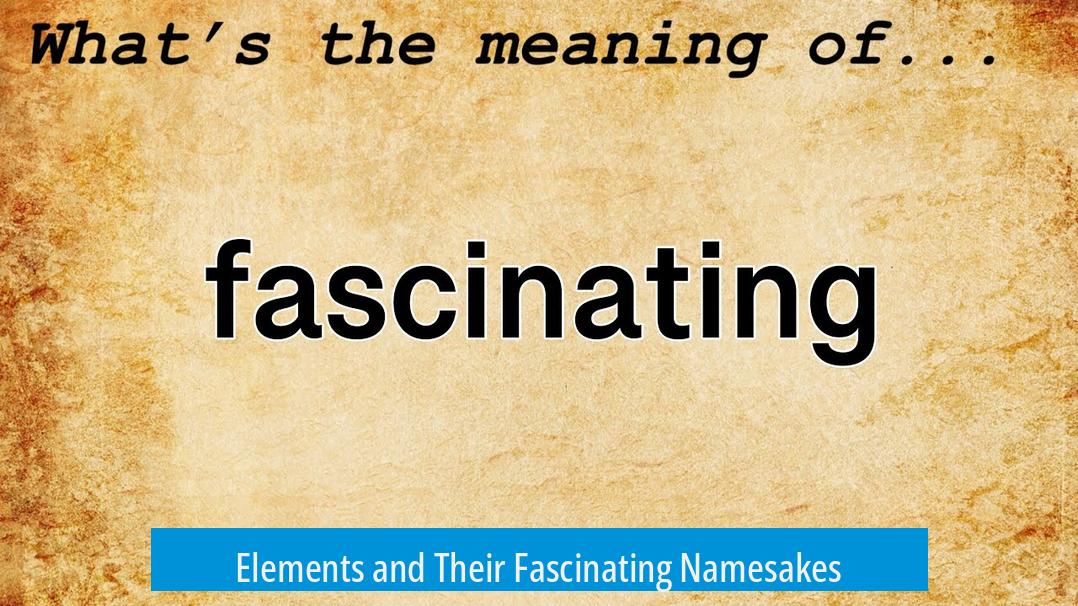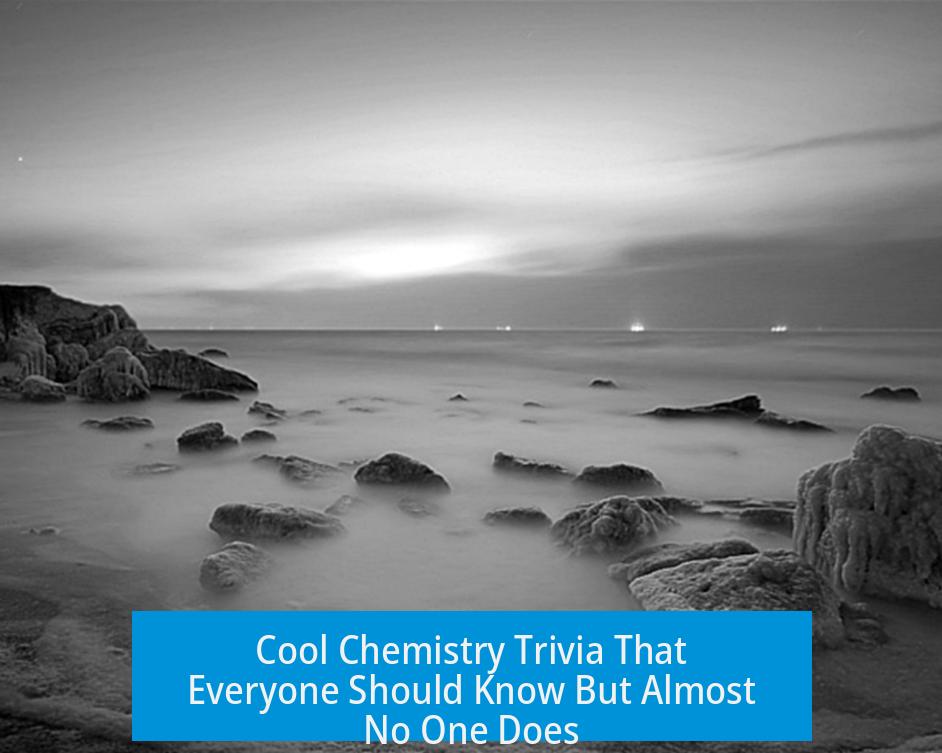Chemistry Trivia So Cool Everyone Should Know But Almost No-One Does
Chemistry trivia that surprises most people reveals fascinating stories about elements, industrial processes, alchemy, quantum effects, and the origins of scientific discoveries. Many lesser-known facts unlock a deeper appreciation for chemistry’s role in history, technology, and everyday life.
Elements and Their Fascinating Namesakes

Argentina and Argentum: A Country Named After Silver
Argentina uniquely derives its name from the Latin word for silver, Argentum. Early European explorers believed in a mythical mountain of silver—the Sierra de la Plata. This lore inspired the country’s name, linking geography to chemistry through silver’s symbol Ag.
The Copper-Cyprus Connection
While some claim the island nation Cyprus is named after copper, the chemical element Cu (from Cuprum), scholars dispute this. Evidence suggests copper’s Latin name may originate from Cyprus, not vice versa.
Elements Named After Living People

- Very few elements honor living individuals.
- Seaborgium (Sg, 1997) honors Glenn Seaborg during his lifetime.
- Oganesson (Og, named 2016) honors Yuri Oganessian, alive as of 2023.
These rare namings acknowledge contemporary contributions to chemistry and nuclear science.
Industrial Chemistry’s World-Changing Impact
Haber-Bosch Process: Feeding Billions
The Haber-Bosch process synthesizes ammonia from nitrogen and hydrogen. This industrial feat supports over half the global population by enabling synthetic fertilizers. Remarkably, it consumes about 1% of the world’s energy.
Fritz Haber: Dual Legacy

Fritz Haber embodies chemistry’s dual nature. Besides co-inventing the ammonia process, he led chemical warfare efforts using poison gas in WWI. His story reflects chemistry’s complex ethical dimensions and societal impact.
Gold’s Chemistry and Hidden Stories
Saving Nobel Medals with Aqua Regia
Georg de Hevesy saved Nobel medals from Nazi theft during WWII by dissolving them in aqua regia, a powerful acid solution. The gold remained hidden in this form until after the war, when it was recovered and reformed into medals.
The Lycurgus Cup: Ancient Nanotechnology

The Roman Lycurgus Cup, displayed in the British Museum, exhibits unique color-changing properties. Containing gold nanoparticles, it appears green in normal light but glows red when backlit. This surface plasmon resonance effect is an early, accidental example of nanoscale chemistry.
Alchemy: Forebears of Modern Chemistry
Alchemy Without Atomic Theory
Alchemists were not ignorant but lacked atomic models. Their experiments laid groundwork for metallurgy and extraction methods. For example:
- Gold and silver could be isolated from copper and lead ores.
- They searched for ways to produce precious metals from common substances.
Their efforts, though fruitless in transmutation, advanced chemical knowledge significantly.
Societal Contributions of Alchemists

Alchemists pioneered techniques, often working under social and political constraints. Their legacy includes chemical apparatus design, purification methods, and early pharmaceuticals. These practitioners deserve recognition as chemistry’s true pioneers.
Quantum and Physical Chemistry Trivia
Tunnel Effect in Biology
Quantum tunneling accelerates many biochemical reactions by allowing hydrogen atoms to cross energy barriers. Around 30% of reactions rely on this. Deuterium, a heavier isotope, tunnels less effectively and can disrupt biological processes, causing toxicity.
Relativistic Effects Shape Gold and Mercury

Gold’s softness and mercury’s liquidity stem from relativistic effects on electrons orbiting their heavy nuclei. Electrons approach the speed of light, contracting orbital paths (Lorentz contraction). This shrinks s-orbitals, weakening bonds and altering metal properties. Mercury’s vapor pressure means inhalation risk near its liquid form.
Historical Chemical Concepts and Discoveries
Phlogiston and the Discovery of Oxygen
The 17th-century phlogiston theory posited a fire-like element released during combustion. It was ultimately debunked by Joseph Priestley and Antoine Lavoisier, who discovered oxygen. Lavoisier renamed it “oxygen,” clarifying combustion and respiration chemistry.
Salicylic Acid and Aspirin Origins
Salicylic acid traces to willow bark, deriving from the Latin salix. Ancient healers used willow extracts for pain relief. Chemists later synthesized pure salicylic acid and acetylated it to form aspirin, a revolutionary analgesic.
Sorensen’s pH Scale and Carbonated Drinks
- Sørensen developed the pH scale to standardize acidity measurements, aiding brewing industries.
- He also pioneered carbonation techniques, using fermentation CO2 to create sparkling beverages.
Name Origins: Aluminum vs. Aluminium
The metal’s discoverer initially named it “aluminum.” The British later adopted “aluminium” for euphony. Despite spelling differences, the chemical symbol remains Al. The correct pronunciation is “aluminum.”
Fascinating Properties of Elements and Compounds
Ammonium Fluoride and Ice Cocrystallization
Ammonium fluoride uniquely cocrystallizes with ice, forming solid solutions with remarkable structural properties. This is rare among compounds and useful for studying phase interactions.
Phosphorus Discovery from Urine
Hennig Brand isolated phosphorus by heating urine, a hopeful step in alchemy’s quest for the philosopher’s stone. This discovery marked the first new element identified chemically rather than just observed.
Silver vs. Gold Abundance Above Ground
Unexpectedly, silver is rarer above ground than gold despite being more abundant geologically. This scarcity affects economic value and industrial applications.
Skatole in Perfume Industry
Skatole, an organic compound causing fecal odor, paradoxically appears in perfumes at low concentrations. It contributes floral and jasmine notes, making it valuable in fragrance formulations despite its name.
Helium’s Unique Physical Behavior
- Helium remains a liquid down to absolute zero under atmospheric pressure; it does not freeze.
- Its small atomic size enables leakage from containers, causing balloons to deflate over time.
- Magnetic storage could theoretically contain helium indefinitely.
- Helium originates deep underground from radioactive decay but escapes to the atmosphere where solar wind strips it away.
- While helium itself is not depleted, cheap accessible sources may become scarce, impacting industries relying on it.
Lead’s Palatable Danger
Lead reportedly tastes sweet, increasing the risk of accidental ingestion, especially in children. This property heightens concern over lead poisoning.
Chemical History and Word Origins
Origin of “Vitriol”
The word “vitriol” meaning harsh criticism originates from Latin vitrum (glass). Blue vitriol (copper sulfate) formed large glassy crystals. Replacing copper with protons yields sulfuric acid, once called “vitriolic acid,” known for its corrosiveness. The metaphorical use follows from the acid’s caustic nature.
JJ Thomson’s Electron Discovery
JJ Thomson discovered the electron using cathode rays and created the first mass spectrometer. His son went on to demonstrate the electron’s wave properties, expanding the understanding of quantum mechanics.
Mendeleev and Russian Vodka
Dmitri Mendeleev, famous for the periodic table, conducted doctoral research on vodka distillation. He standardized vodka strength, influencing Russian beverage production to this day.
Chemical Boiler Treatment from Potatoes
Workers noticed that potato cooking prevented boiler corrosion. They identified hydroquinone, an oxygen scavenger, as the protective agent, leading to industrial chemical treatments to prevent rust.
Key Takeaways
- Argentina is uniquely named after a chemical element—silver (Argentum).
- The Haber-Bosch process sustains much of the world’s food supply and consumes significant global energy.
- Gold nanoparticles in the Lycurgus Cup represent ancient, accidental nanotechnology.
- Quantum tunneling is vital in biochemistry, especially hydrogen transfer reactions.
- Relativistic effects alter elemental properties like gold’s softness and mercury’s liquidity.
- Alchemists laid foundational chemical knowledge despite lacking atomic theory.
- Helium’s unique properties affect storage and supply concerns for technology and science.
- Chemistry terminology often traces back to historical observations and uses.
Chemistry Trivia That’s So Cool Everyone Should Know — But Almost No One Does
Ever found yourself thinking chemistry is just boring equations and weird smells? Well, gear up — because chemistry hides some mind-blowing stories and facts that almost no one talks about, but *definitely* should. These tidbits connect history, industrial revolutions, quantum quirks, and even accidental ancient nanotechnology. Ready to impress everyone at your next trivia night? Here’s a treasure trove of chemistry trivia that is too cool to ignore.
What’s the coolest chemistry trivia nobody knows? It’s that chemistry isn’t just about lab coats and test tubes — it’s tied deeply to nations, wars, nanotech art, and secrets behind everyday objects.
1. Elements and Countries: When Chemistry Meets Geography
Did you know that Argentina is the only country named after an element? Yep! Its name comes from the Latin Argentum, which means silver. Early explorers thought this land hid a mountain of silver – Sierra de la Plata – hence the name. This mingling of chemistry and geography is rare but fascinating.
But what about copper and Cyprus? There’s a popular myth that Cyprus is named after copper’s Latin root, Cuprum. Actually, it’s the other way around—copper was named after the island, not vice versa. True story!
Speaking of namesakes, only two elements bear the names of living people: seaborgium and oganesson. Glenn Seaborg got his honor in 1997 while alive, and Yuri Oganessian’s name was bestowed in 2016. Imagine discovering an element and seeing it named after you — how cool is that?
2. The Haber-Bosch Process: Chemistry Feeding the World — Literally
This industrial gem is one of chemistry’s biggest unsung heroes. The Haber-Bosch process synthesizes ammonia on a massive scale; it’s responsible for producing fertilizers that feed about half of the world’s population. It uses around 1% of the entire world’s energy. That’s not small potatoes!
But here’s the twist: one of its inventors, Fritz Haber, also led efforts to develop poison gas during WWI. He’s a classic double-edged sword — saving millions through agriculture but also causing devastating harm on the battlefield. Chemistry can be dramatic!
3. Gold’s Glittering Secrets: Medals, Roman Art, and Nanoparticles
Here’s a story worthy of a spy thriller. During WWII, Hungarian chemist Georg De Hevesy hid two Nobel medals from Nazis by dissolving them in aqua regia—a mix of acids strong enough to dissolve gold. He secretly stored the gold solution in his lab cupboard. After the war, he precipitated the gold and had new medals made. Talk about chemistry as a super stealth move!
And did you know the Romans accidentally created nanoparticles? The British Museum’s Lycurgus Cup glows red when backlit. That’s because its glass contains microscopic gold particles that interact with light via surface plasmon resonance. The Romans didn’t know quantum physics—they just stumbled upon ancient nanotech. Chemistry magic from 1,600 years ago!
4. Alchemists: Misunderstood Wizards of Chemistry’s Past
Alchemists get a bad rap. They weren’t crazy—they simply lacked atomic theory. Their quest for gold led them to discover a lot of metallurgy and chemical processes. They could extract silver from lead ores, and small amounts of gold from copper ores.
Imagine if someone today could turn lead into gold efficiently. It would be an economic game changer! Although the grand prize—turning one common metal into another cheaply—remains elusive, alchemists laid the ground for modern chemistry through sheer experimental grit. They deserve applause!
5. Quantum Chemistry: Strange Phenomena in Biology and Metals
Here’s a fun fact for your next party: about 30% of biochemical reactions involve hydrogen atoms “tunneling” through energy barriers. This quantum tunnel effect speeds up reactions crucial for life. Swap hydrogen with deuterium (a heavier isotope), and reactions slow dangerously down, which explains deuterium’s toxicity in large amounts.
Gold and mercury share a bizarre link via relativity! Their heavy atomic nuclei accelerate electrons near light speed, causing orbitals to contract under Lorentz contraction. This makes gold softer than you might expect and mercury liquid at room temperature. So, physics isn’t just about stars—it affects why gold gleams and mercury flows!
6. Classic Chemistry Discoveries with Surprising Backstories
Think the phlogiston theory is just an ancient mistake? Actually, it was a stepping stone. Back in 1667, Johann Joachim Becher thought fire was caused by an element called phlogiston. This idea indirectly led to Joseph Priestley’s discovery of oxygen in 1774, called initially “dephlogisticated air.” Science is full of detours!
Ever wonder where aspirin comes from? Salicylic acid, aspirin’s precursor, is named after the willow tree genus Salix. Willow bark has been medicine for ages — cheers to chemistry for isolating the painkiller!
Sorensen invented the pH scale working for the Carlsberg brewery to keep lagers consistent. Plus, he came up with carbonated drinks to cleverly use fermentation’s CO2. Next time you sip soda, thank chemistry and brewing science.
Aluminum (US spelling) came before aluminium (UK style). An English discoverer named it aluminum, but Brits preferred aluminium because it “sounds better.” The correct pronunciation? Aluminum. Words can be chemistry too!
7. Elemental Oddities and Their Hidden Quirks
Ammonium fluoride is the only compound that can co-crystallize with ice. If you’ve ever wondered which chemical buddies up with ice, there you go.
Phosphorus was discovered by heating concentrated urine during the quest for the philosopher’s stone. Yep, ancient alchemy meets…well, pee.
Here’s a twist: above ground, silver is actually rarer than gold. Not your everyday fact!
Perfumes contain something called skatole—an ingredient that smells floral in tiny amounts despite being a smelly compound at higher levels. So when you ask the perfume price, you’re partially right calling it “that stuff.” Chemistry can be funny!
Helium won’t freeze even at absolute zero under atmospheric pressure. Plus, helium atoms are so tiny they leak out of containers, making party balloons deflate all by themselves. We don’t have a helium shortage, but cheap, accessible helium is getting harder to find. The race for this light gas is real.
One last strange note: lead tastes good, which is exactly why it’s so harmful, especially to kids.
8. Chemistry’s Word Origins and Historical Nuggets
The word “vitriol” means cruel criticism but comes from Latin for “glass.” This is because copper sulfate’s large blue crystals resembled blue glass and were called “blue vitriol.” Replace copper with protons, and you get sulfuric acid, or “vitriolic acid,” so harsh it lent the word its figurative meaning.
JJ Thomson discovered the electron and invented the first mass spectrometer. His son went on to prove electrons also behave like waves. Dynamic family, right?
Mendeleev, famous for the periodic table, actually earned his PhD working on Russian vodka distillation. Chemistry and vodka are closer than you’d expect!
Chemical boiler treatment started when workers noticed potatoes cooked in boilers prevented oxidation. Hydroquinone in potatoes scavenged oxygen, sparing the metal from rust. Peeling potatoes saved boilers — and that’s a tidy bit of applied chemistry.
Final Thoughts
These aren’t your typical chemistry facts. They show how chemistry weaves through history, culture, physics, and even art. From ancient Roman nanotech to quantum tunneling in your body, chemistry trivia can be mind-bending and marvelously cool. Next time someone says chemistry is boring, just share one of these and watch jaws drop. Because the real magic of chemistry is the amazing stories it whispers about our world.
Q1: Which country is named after an element and what is the origin of its name?
Argentina is named after silver, called Argentum in Latin. Its name comes from the myth of the Mountain of Silver believed to be there. It’s the only country named after an element.
Q2: How did Georg De Hevesy save Nobel medals during World War II?
He dissolved two Nobel medals in aqua regia, a powerful acid mixture. The solution was stored secretly, then after the war, the gold was recovered to remake the medals.
Q3: What is the Haber-Bosch process and why is it important?
This industrial method fixes nitrogen to produce fertilizer. It uses about 1% of the world’s energy and helps feed nearly half the global population.
Q4: Why are gold and mercury physically unusual metals?
Their electrons move near light speed causing relativistic effects. This shrinks certain orbitals, making gold soft and mercury liquid at room temperature.
Q5: What is the tunnel effect and its role in biology?
Hydrogen atoms can tunnel through barriers during reactions, speeding processes. Heavy deuterium tunnels less, which can slow or harm biological functions.





Leave a Comment